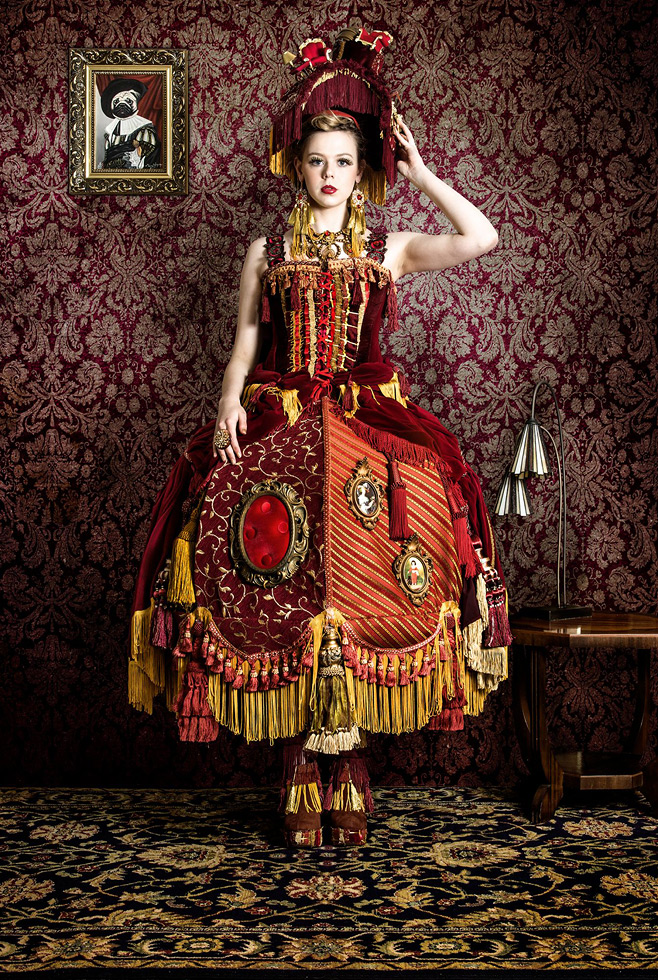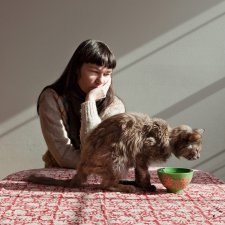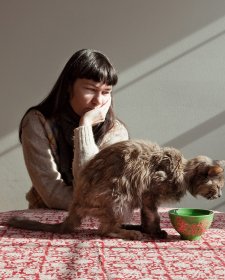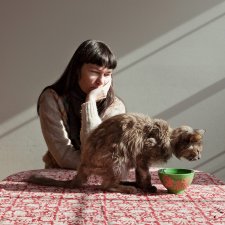How do you define your practice?
Artist.
Do you have a website or are you represented on a website?
I don't have my own website but by work can be seen on numerous sites of the exhibitions and publications that I have been in. I have exhibited in several group shows at the Brenda May Gallery in Danks street Waterloo and I have some of my photographs in their stock room.
How would you describe your relationship to the subject/s?
Mikala is the eldest of my three daughters. I have photographed her on many an occasion. Needless to say we are both extremely at home with the practice.
Was the photograph a result of a constructed, fabricated or candid encounter? Please describe.
The photograph was a constructed image with a touch of fabrication. Tess, my sixteenyear- old daughter, made the garment for the Apex Teenage Fashion Awards and the photograph is a true representation of it. The pug painting, carpet, lamp and table were all part of the original image but the background was added in Photoshop.
What are the ideas or themes underpinning your portrait?
My portrait titled The living room is not part of a series but a one-off image. My aim was to document my daughter wearing this amazing garment that was inspired by the Victorian lounge room. Her legs were positioned to look like the stand of a lampshade, steady and strong while at the same time she stabilises the fragile and heavy headdress.
Please describe the technical aspects of your photograph?
The portrait was made with a Sony a77 DSLR which is a 24 mega pixel camera using the RAW mode. I used two Elinchrom Flash Heads with umbrellas to create soft, modelled light and a large white reflector to bounce light into the darker areas. The image was then processed in Adobe cs6 Camera RAW using a combination of formulas and Photoshop techniques.
How was the final print made? Is this print one of an edition?
I printed the final image on an Epson 9600 printer using Ilford Gold Fibre Silk digital paper. I used the manufacturer's paper profile and colour proofed extensively before I was completely happy with the result. The image is part of an edition of five.
Describe your consideration of scale, mounting and framing in the presentation of your portrait?
I selected a traditional wooden frame with a small decorative component to suit the ornate quality of the photograph. The dark wood echoed the colours in the furniture and the soft creamy pink mount to mirror the colour of the model's skin. I like working in a larger format and in this case I believe it allows the viewer to see the detail and textures within the print.
Who would you nominate as your influences?
In 1978 I was introduced to the work of Diane Arbus. I thought her photographs were the most amazing images I have ever seen. I'm not sure that I would describe her as an influence but she is certainly my favourite photographer. I believe I am influenced by events or issues rather than other photographers.
Do you have any advice for young photographers (eg. students)?
Be true to yourself.














